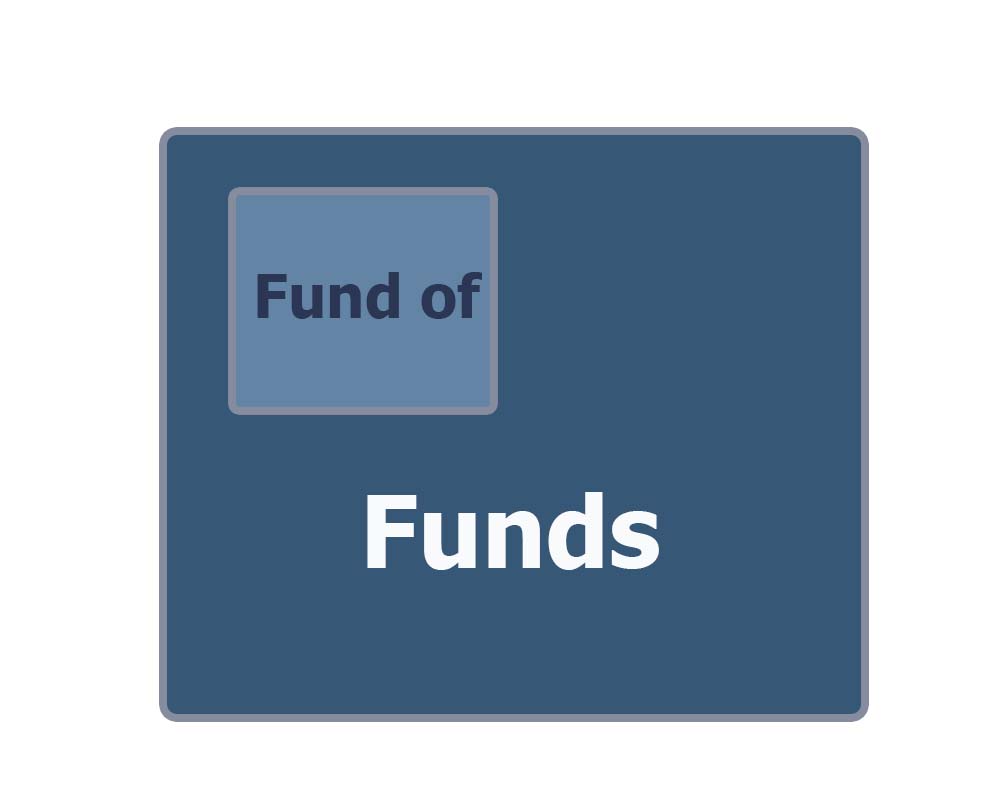A fund of funds (FoF) is an investment strategy that involves pooling investors’ money to invest in a portfolio of other investment funds, rather than directly investing in individual securities or assets. In other words, a FoF invests in other mutual funds, hedge funds, or exchange-traded funds (ETFs) rather than directly buying stocks, bonds, or other assets.

Types of a FoF
- Multi-asset
- Hedge
- Private equity
- Real estate
- Venture capital
Multi-Asset
Multi-Asset FoF is a type of investment fund that invests in a diversified portfolio of other investment funds across multiple asset classes. Instead of directly holding individual stocks, bonds, or other securities, this fund allocates its assets among various underlying funds managed by different fund managers. The goal of a Multi-Asset FoF is to achieve broad diversification and potentially higher returns by spreading investments across a range of asset classes, such as stocks, bonds, real estate, commodities, and alternative investments. This approach allows investors to gain exposure to a wide array of investment opportunities while benefiting from the expertise of multiple fund managers.
Hedge fund of funds
A hedge FoF is an investment vehicle that pools capital from investors and invests it in a portfolio of hedge funds. Rather than investing directly in individual securities or assets, a hedge funds allocates its assets across various hedge funds managed by different investment managers. The goal is to achieve diversification and potentially higher returns by spreading investments across multiple hedge fund strategies, asset classes, and managers.
Private equity fund of funds
Investing in a private equity FoF allows investors to gain exposure to a wide range of private companies and investment opportunities that may not be accessible to individual investors.
Real estate fund of funds
Investing in a real estate FoF allows investors to gain exposure to a wide range of real estate assets and investment opportunities without the need for direct property ownership. Additionally, by leveraging the expertise of multiple real estate fund managers, investors can benefit from specialized knowledge and experience in different sectors and investment strategies.
Venture capital fund of funds
The primary goal of a venture capital FoF is to provide investors with exposure to a diversified portfolio of early-stage and growth-stage companies. By investing in multiple venture capital funds, investors gain access to a broad range of startups and emerging businesses across different industries and sectors.
How does it work?
Their main strategy is focused on achieving broad diversification and appropriate allocation of investment assets across various fund categories that are combined into one portfolio.
There are different types of FoF, and each type operates according to its investment scheme. These funds can have the structure of a hedge fund, direct investment fund, or investment trust. They may invest only in portfolios managed by one investment company. They can also invest in external funds controlled by other managers from different companies or even countries.
Advantages of a fund of funds
- Diversification
- Professional Management
- Access to Expertise
- Convenience
- Risk Management
- Flexibility
- Cost Efficiency
Typically, fund of funds managers are experienced professionals in their field. They provide individual investors access to assets that are inaccessible or difficult to access in a single geographic region. Another key advantage is convenience.
Disadvantages of a fund of funds
- Fees:
- Potential Over-Diversification
- Lack of Control
- Manager Selection Risk
- Double Layer of Fees
- Tax Inefficiency
- Limited Transparency
Funds of funds typically incur management fees in addition to the fees charged for managing the underlying funds. Another drawback is over-diversification resulting from holding too many underlying assets. All investment decisions are made by the fund manager rather than the investor, and performance relies on the manager’s skills.
Which country has the most of them?
The United States has the most fund of funds, given its large and diverse financial market, extensive network of investment firms, and robust regulatory framework.
Who can invest?
Investing in fund of funds is open to various categories of investors, such as individual investors, institutional investors, pension funds, insurance companies, and other financial institutions.
Can retail investors invest?
Yes, small investors can invest in it. The minimum investment amount in a FoF can vary from fund to fund. Some funds may have a lower threshold for investments, such as $1,000 or $5,000, while others may require larger amounts, such as $10,000 or more. It’s best to check the requirements of a specific fund of funds to find out about the minimum investment amount.
What is the difference between alternative investment funds and fund of funds?
Alternative investment funds invest in specific assets, such as real estate, startups, infrastructure, precious metals, or art objects. FoF, on the other hand, invest in these funds, significantly enhancing portfolio diversification.
Key takeaways
- This is a pooled fund that invests assets in other investment funds.
- They typically invest in assets in other hedge funds or mutual funds.
- Their strategy aims to achieve broad diversification with minimal risk.
- They generally have higher expenses than regular investment funds.
Pingback: Alternative Investment Funds (AIFs) - Stock 'n Investments